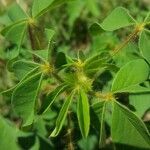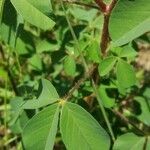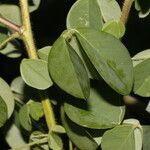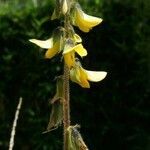Herb or small shrub, less than 1 m (-2 m) tall, stem terete, puberulous to pilose. Leaves trifoliolate, the terminal leaflets elliptic or obovate, apex rounded, mucronate or mucronulate, the base cuneate 1.8-6.0 cm long, 1.1-3.7 cm broad, the margins entire, above glabrous, strigose or pilose, beneath glabrous to pilose or villous, the veins 6-9 on each side of the midvein, the lateral leaflets similar, but slightly smaller; petiole 2-7 cm long; stipules caducous. Inflorescences ter-minal or sub-terminal racemes bearing 7-11 flowers; bracts setaceous and curly, deciduous before anthesis; pedicels 1.8-2.0 mm long; bracteoles narrowly trian-gular ca. 2 mm long, pilose, located on the top of the pedicel, caducous. Flowers yellow, 11-15 mm long; calyx 7.5-10.0 mm long, the tube campanulate, the lobes 2.5-3.0 times as long as the tube, pilose; corolla yellow, 10-13 mm long, the standard 11-14 mm long, 10-13 mm broad, retuse, the wings 10-13 mm long, the claws 1.5-1.9 mm long, oblong, oblique, the keel 12 mm long, the non-twisted beak short; stamens dimorphic, the long anthers 1.3-1.8 mm long, the short anthers 0.5-0.6 mm long; style with pubescent stigma, geniculate, 7.0-8.3 mm long. Legume inflated, 2.5-3.5 cm long, pilose, brown at maturity; seeds ca. 33, brown, oblique cordiform, to 3.0 mm long.
Herbs or shrublets, to 1 m tall. Stems brownish yellow spreading pubescent. Stipules acicular, 2-3 mm, tardily caducous. Leaves 3-foliolate; petiole 3-5 cm; petiolules 1-3 mm; leaflet blades elliptic-obovate, obovate, or suborbicular, 2-4 × 1-2 cm, terminal one larger than lateral ones, thin, abaxially pubescent to nearly glabrous, adaxially glabrous, secondary veins 6-10 on each side of midvein, secondary and tertiary veins abaxially distinct and adaxially inconspicuous, base rounded to broadly cuneate, apex obtuse and mucronate. Racemes terminal or leaf-opposed, 10-20 cm, 5-15-flowered; bracts 1-10 mm, caducous. Pedicel 3-4 mm; bracteoles inserted at base of calyx tube, similar to bracts, 2-3 mm. Calyx subcampanulate, 6-8 mm, 5-lobed, pubescent; lobes lanceolate, longer than tube. Corolla yellow, exserted beyond calyx; standard elliptic, 8-10 mm, base with appendages, apically usually pilose; wings oblong, 8-10 mm; keel ± as long as wings, abruptly rounded below middle, beak well developed and incurved. Legume clavate, 2-3 × 0.7-1 cm, apically slightly oblique, 20-30-seeded, densely rusty pilose; stipe ca. 2 mm. Fl. Oct-Dec, fr. Jan-Feb.
A herb or small shrub. It grows 1 m tall. The stems are yellow to brown and hairy. The leaves have 3 leaflets. These are oval and 2-4 cm long by 1-2 cm wide. The end one is largest. There are 5-15 flowers in a group about 10-20 cm long at the ends of the branches. They are yellow. The pod is 2-3 cm long by 1 cm wide. There are 20-30 seeds.
Leaves 3-foliolate; leaflets up to 2.5–5 × 1.7–4.5 cm, elliptic-obovate to obovate or subcircular, rounded to retuse at apex, usually thinly pilose beneath; petioles mostly longer than leaflets; stipules 2.5–12(20) mm long, filiform.
Standard elliptic, yellow, veined reddish-brown or purple, glabrous or medially pubescent outside; wings nearly as long as keel; keel 8–11.5 mm long, bent at right-angles in lower half, lanate-pilose on upper margin.
Racemes usually lax, few–many-flowered; bracts 1–10 mm long, subulate or linear; bracteoles curved-ascending from just below calyx, 2–6 mm long, linear.
Seeds 2.5–3 mm long, oblique-cordiform, smooth or obscurely papillose, pale brown, mottled darker, or olive-green.
Calyx 7–11 mm long, subglabrous to spreading pilose; lobes narrow, ± twice as long as tube.
Erect or spreading usually rather bushy herb, up to 1.5(3.5) m tall, variously hairy.
Pod 3–4.5 cm long, fusiform-clavate, subsessile, somewhat pointed, pilose.
Coarsely hairy stems and fruits
Flowers yellow, veined purple.
A herb, 2–4 ft. high












